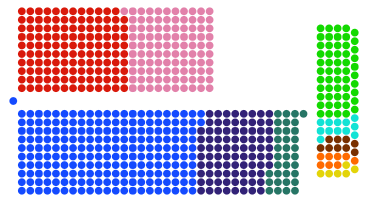2017 Capsland General Election
This article is incomplete because it is pending further input from participants, or it is a work-in-progress by one author. Please comment on this article's talk page to share your input, comments and questions. Note: To contribute to this article, you may need to seek help from the author(s) of this page. |
| |||||||||||||||||||||||||||||||||||||||||||||||||||||||||||||||||||||||||||||||||||||
All 650 seats to the National Parliament This is the result of the largest six parties, for the full result see below 326 seats needed for a majority | |||||||||||||||||||||||||||||||||||||||||||||||||||||||||||||||||||||||||||||||||||||
|---|---|---|---|---|---|---|---|---|---|---|---|---|---|---|---|---|---|---|---|---|---|---|---|---|---|---|---|---|---|---|---|---|---|---|---|---|---|---|---|---|---|---|---|---|---|---|---|---|---|---|---|---|---|---|---|---|---|---|---|---|---|---|---|---|---|---|---|---|---|---|---|---|---|---|---|---|---|---|---|---|---|---|---|---|---|
| Turnout | 69.20% | ||||||||||||||||||||||||||||||||||||||||||||||||||||||||||||||||||||||||||||||||||||
| |||||||||||||||||||||||||||||||||||||||||||||||||||||||||||||||||||||||||||||||||||||
 Results in the National Parliament | |||||||||||||||||||||||||||||||||||||||||||||||||||||||||||||||||||||||||||||||||||||
| |||||||||||||||||||||||||||||||||||||||||||||||||||||||||||||||||||||||||||||||||||||
The 2017 Capslandian snap general election was called for the 22nd of June 2017. The then Executive Chancellor, Bryant Rennard, was forced by the Senate to call the election due to the collapse of the governing SDP-GLA-LP coalition following the 2017 Nashwell Scandal. The election was the first snap election since the assassination of EC Richard Cray in 1875 and the first snap election ever since the Malbury Voting Reform in 1971.
Background
Bryant Rennard's coalition was formed in 2015 and introduced many measures relating to Nashwell, the nation's public health service. The coalition remained intact and united until the early months of 2017. On the 4th of February, 2017, the Social Democratic Lord-Secretary of the Treasury, Mike Gaugar MP, announced that the promised ₡1 billion cash injection for Nashwell would not be committed that year. The failure to fulfil a key SDP manifesto pledge prompted fury from the electorate resulting in the largest doctor's union, NUFDoc, voting for strikes throughout the month of March crippling Nashwell services nationwide.
17 days later, on the 21st of February, an anonymous whistleblower leaked a government dossier detailing further government aims to privatise Nashwell services in apparent 'cost-saving measures'. The unnamed dossier went into further detail on how the Libertarian Union and Social Democratic Party would conspire against their coalition partners in the GLA to force through a parliamentary motion with the unbeknownst help of the opposition to make legal changes to the way Nashwell was structured.
With the revelation that the SDP were going against their manifesto pledges regarding Nashwell, the GLA formally pulled out of the coalition on the 8th of April. Leading to the Senate to force through a snap-election in the following months.
Bryant Rennard promised to resign as leader of the SDP after the election was concluded. He resigned on the 5th of July, 12 days after the election results were announced and 5 days after David George's coalition was formed.
Analysis
The debate during the 2017 General Election was dominated by Nashwell funding and the March NUFDoc strikes. Immediately, a day after the general election was called, the Christian Democrats and the Democracy Party announced that they would form a coalition government if possible with a full focus on "restoring Nashwell to pre-SDP standards". This would be the first elections the Christian Democrats would participate in and the first election any two parties would declare they would form a coalition if possible before the results had been counted. The declaration by David George and David Marde soon began to have a positive impact in the polls and one day later the announcement, the Democracy Party overtook the SDP in polls nationwide. Many political analysts saw this as a Democracy Party tactic to stem the potential loss of voters to the three new parties, who all had elements of centre-right politics.
This election was also Capsland's most crowded election with a total of ten parties taking part nationally. The new parties, the Popular Front, Christian Democrats and National Liberal Party were able to contest the election due to a loosening on the restrictions on political party formation by the Electoral Commission. In total, new parties received
Results

| |||||
|---|---|---|---|---|---|
| Party | Leader(s) | Votes | % | Seats | +/– |
| Democracy Party | David George | 12,406,120 | 32.61 | 212 | +10 |
| Social Democratic Party | Brant Rennard | 7,786,694 | 19.84 | 129 | -105 |
| Socialist-Bloc | Wilson Daniels | 6,083,356 | 15.50 | 101 | +64 |
| Christian Democrats | David Marde | 5,161,040 | 13.15 | 85 | +85 |
| Green and Liberal Alliance | Natalie Mason & Jeremy Garth | 3,233,990 | 8.24 | 54 | -32 |
| Popular Front | Gordon Hughmann | 2,060,491 | 5.25 | 34 | +34 |
| Liberation Party | Julien Piccard | 733,927 | 1.87 | 12 | +3 |
| National Liberal Party | Jared Garbute | 545,540 | 1.39 | 9 | +9 |
| Libertarian Union | Guy Garrison | 459,195 | 1.17 | 8 | -31 |
| Capsland Sovereign Party | Henry Farthing | 384,625 | 0.98 | 6 | -37 |
| Total | - | 38,854,978 | 100 | 650 | - |
| Registered voters/turnout | - | 56,148,000 | 69.20 | - | - |





